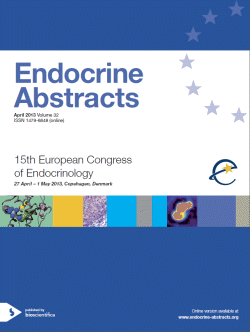Searchable abstracts of presentations at key conferences in endocrinology
Symposia
Clinical impact of rare mutations in endocrinology
ea0032s31.1 | Clinical impact of rare mutations in endocrinology | ECE2013
Does a new mutation always predict a new disease? Lessons from p27 mutations
A few years ago a novel multiple endocrine neoplasia syndrome, named MEN type 4 (MEN4), was discovered thanks to studies conducted on a MEN syndrome in the rat (named MENX). Rat and human syndromes are both caused by germline mutations in the Cdkn1b/CDKN1B gene encoding p27Kip1, a putative tumor suppressor which binds to and inhibits cyclin/cyclin dependent kinase complexes, thereby inhibiting cell cycle progression. MEN4 patients carry heterozygous mutations...
ea0032s31.2 | Clinical impact of rare mutations in endocrinology | ECE2013
Old and new MEN1 mutations
Multiple endocrine neoplasia type 1 (MEN1 OMIM 131100) is considered as the major hereditary syndrome predisposing to multifocal endocrine tumors and a broad spectrum of non-endocrine lesions. Since the cloning of the MEN1 gene in 1997, a large number of studies have shown the large diversity of germline mutations found in patients with a poor genotype phenotype correlation. Menin, the protein encoded by the MEN1 gene interacts with more than 30 nuclear/cellular ...
ea0032s31.3 | Clinical impact of rare mutations in endocrinology | ECE2013
Genetic diagnosis of hereditary neuroendocrine syndrome in asyntomatic patients: clinical and prognostic implications
Faggiano Antongiulio , Ramundo Valeria , Marciello Francesca , Del Prete Michela , Marotta Vincenzo , Colao Annamaria
Neuroendocrine tumours (NETs) can be sporadic or can arise in complex hereditary endocrine disorders such as multiple endocrine neoplasias (MENs), familial paragangliomatosis (FPGLs), neurofibromatosis type 1 (NF1), von HippelLindau disease (VHL), tuberous sclerosis (TSC). It has been estimated that hereditary NET occurrence varies with site of origin of the tumour, representing 530% of all cases of NET. These rates seems to be an underestimation and novel mutation...




